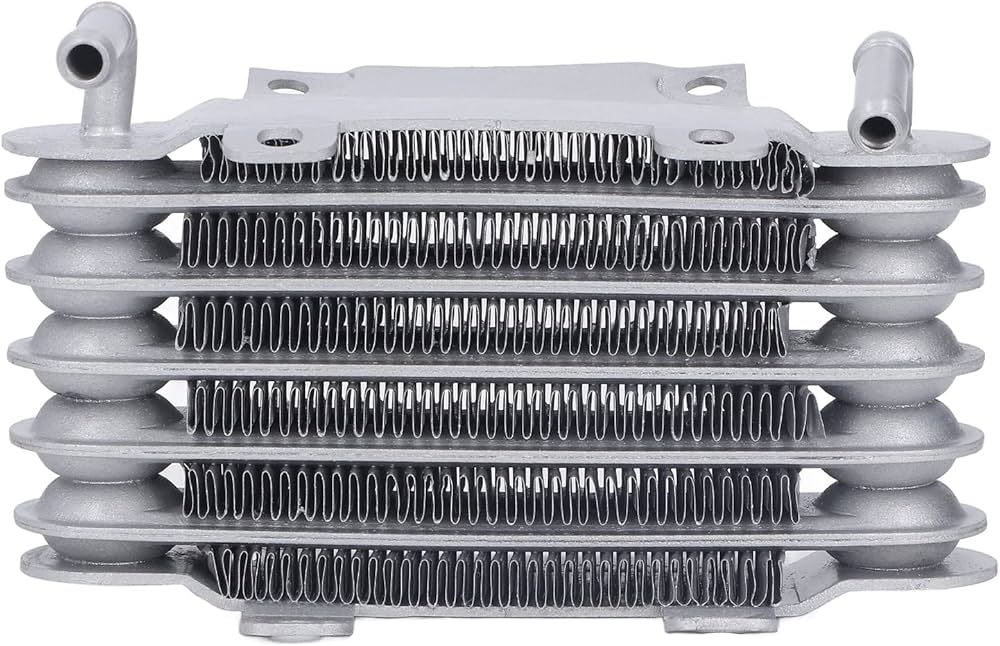Introduction
Motorcycle engine oil cooler plays a vital role. and acting as a specialized heat exchanger, an oil cooler helps regulate engine oil temperature, ensuring that it maintains its viscosity and lubricating properties even under demanding circumstances. Whether you’re riding through traffic-clogged streets or pushing limits on a highway, having a reliable oil cooling system can make a significant difference in how your engine performs and survives in the long run. Motorcycle engines, especially those used in high-performance, touring, or air-cooled models, often operate under intense conditions that generate substantial heat. Managing this heat is crucial not only for performance but also for engine longevity and oil integrity.
Purpose of an Oil Cooler in Motorcycles
- Temperature Control
Engine oil not only lubricates the engine but also helps in absorbing and dissipating heat. However, beyond a certain temperature, oil loses its viscosity and protective properties. An oil cooler keeps the oil temperature in check. - Extended Engine Life
By maintaining the oil within an optimal temperature range, it prevents thermal stress on engine parts, reducing wear and tear over time. - Enhanced Performance
Cooler oil means better viscosity, which leads to efficient lubrication and smoother engine performance, especially under stress. - Protection in Hot Climates or Heavy Traffic
In tropical climates or during stop-and-go traffic where air-cooled engines struggle, an oil cooler prevents overheating.
How a Motorcycle Oil Cooler Works
The oil cooler operates similarly to a radiator but for engine oil instead of coolant.
Step-by-step Process:
- Oil is Pumped from the Engine:
Hot oil from the engine’s oil pump is diverted toward the oil cooler via oil lines or hoses. - Heat Transfer in the Cooler:
The oil passes through a network of tubes and cooling fins in the cooler. The aluminum or copper fins increase the surface area and help dissipate the heat efficiently as air flows over them. - Cooled Oil Returns:
Once cooled, the oil flows back into the engine, ready to lubricate and protect engine components under optimal conditions.
Types of Motorcycle Engine Oil Coolers
Air-Cooled Oil Coolers
- Most common type.
- Rely on ambient airflow to dissipate heat.
- Simple in design, lightweight, and effective for air-cooled engines.
- Installed typically at the front of the bike for maximum airflow.
Used in:
- Royal Enfield (Classic 350/500), Bajaj Dominar, Harley-Davidson air-cooled models.
Water-Cooled Oil Coolers (Liquid-to-Oil Coolers)
- Use engine coolant (water + antifreeze) to cool the oil.
- Heat is transferred from oil to coolant, which is then cooled by the radiator.
- More efficient in managing heat.
- Found in high-end and liquid-cooled sports or adventure motorcycles.
Used in:
- Kawasaki Ninja H2, BMW GS series, Ducati Panigale.
Fan-Assisted Oil Coolers
- Includes an electric fan mounted on or near the cooler.
- Provides airflow even when the motorcycle is stationary or moving slowly.
- Ideal for city riding, off-road, or heavy traffic conditions.
Used in:
- Modified/custom bikes, adventure bikes, and ATVs.
Construction and Components
- Cooling Fins & Tubes:
Usually made of aluminum or copper, they conduct heat efficiently. - Oil Lines or Hoses:
High-temperature-resistant pipes that connect the oil cooler to the engine. - Mounting Brackets:
To secure the oil cooler to the motorcycle frame, typically at the front. - Thermostatic Valve (Optional):
Regulates oil flow, allowing oil to bypass the cooler until it reaches a specific temperature.
Installation Considerations
Bike Compatibility
- Not all motorcycles are designed to accommodate aftermarket oil coolers.
- Must match your engine’s oil circuit and space availability.
Location
- Must be placed where it receives maximum airflow, typically at the front near the radiator or below the headlamp.
Oil Routing
- Careful routing of oil lines to avoid kinks, sharp bends, or contact with hot parts (like the exhaust).
Mounting
- Secure with strong brackets to withstand vibrations.
- Ensure there is no obstruction to airflow or front wheel clearance.
Conclusion
Motorcycle engine oil cooler is more than just an accessory—it’s a performance and protection upgrade that ensures your engine runs cooler, smoother, and longer. By efficiently dissipating excess heat from the engine oil, it helps maintain optimal lubrication, prevents overheating, and safeguards critical engine components. Whether you’re navigating city traffic, exploring rugged terrains, or racing on open roads, an oil cooler enhances reliability and performance. For riders serious about maintaining their machines, especially in warm climates or demanding riding conditions, installing an oil cooler is a smart investment in both power and protection.

